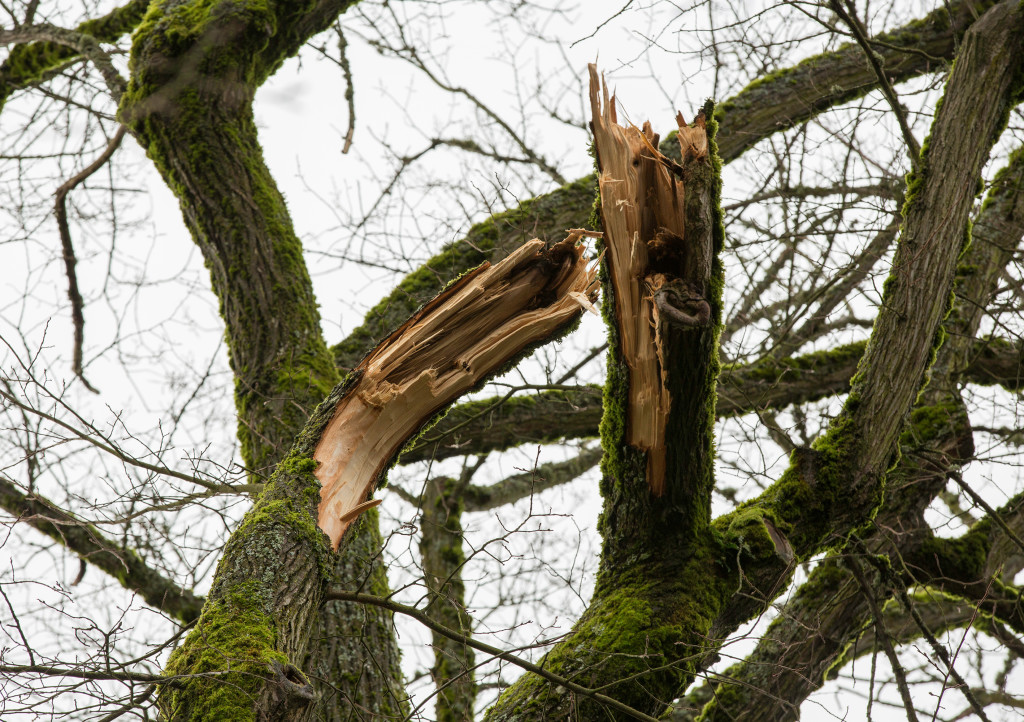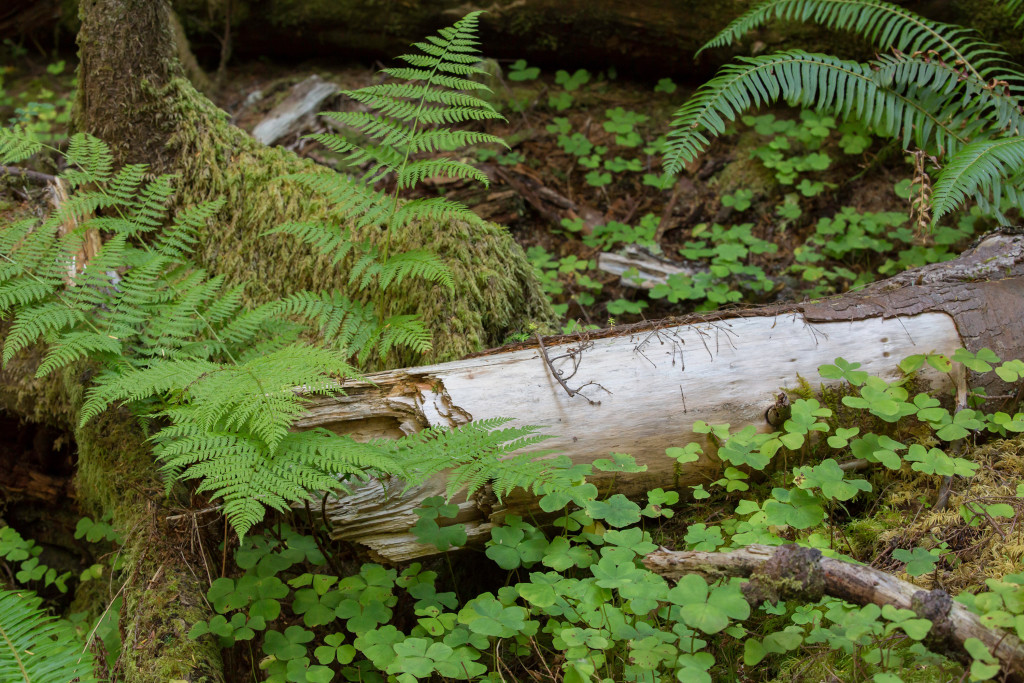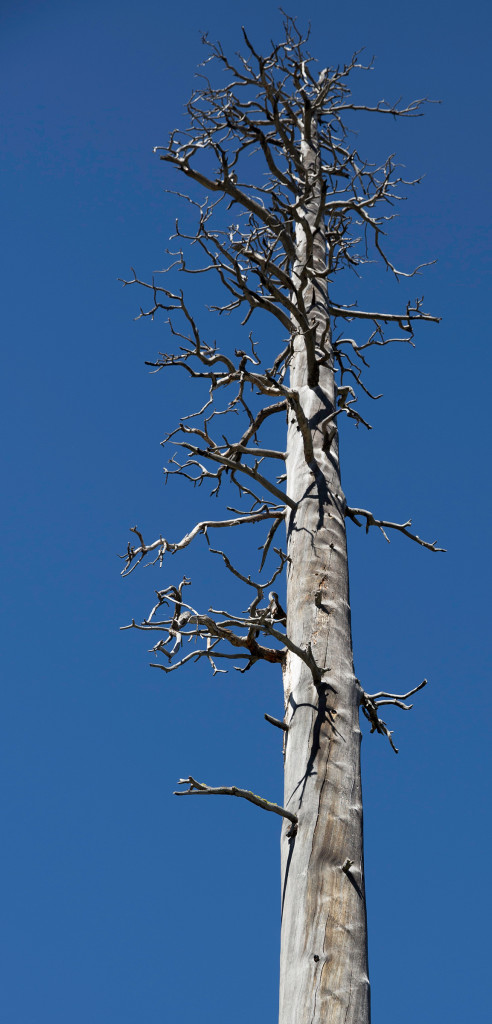
As sad and full of dread as I am about the impending loss of a giant 90-year-old American elm street tree next door, the life that the dying tree supports makes its demise seem much less calamitous. In early March we noticed the familiar tap-tap-tap of a woodpecker on a nearly vertical limb about 40 feet above ground. There, perched on thick, rough bark, was a male downy woodpecker in the process of crafting a perfectly round hole. Since it appeared to be at least two inches deep at that time, I figured that he and his mate had begun excavating the cavity at least a week earlier. The following week the pair ambitiously began work on a second hole, a quarter way around on the same limb, but facing north. Another few weeks passed and we observed them chiseling out yet another hole, this time just below the first one, facing eastward. The branch is angled slightly downward, which keeps out rain and may be less obvious to predators.

What’s with all the holes? Woodpeckers—expert woodworkers of the avian world—including the downy, hairy, pileated, flicker, and many others, hollow out separate chambers for nesting and roosting and, as you’ll read further on, are considered “keystone species” for their crucial role in creating habitat for other woodland species who depend on dead and dying trees in the landscape.
Late in April, it became clear that the third chamber — its depth now at least as long as the birds themselves — would become their little nursery. Excavation of the gourd-shaped cavity continued, but there appeared to be little activity as the month progressed, at least to our eyes and ears, grounded 40 feet below during a very wet, cool spring that kept us indoors more than usual. It wasn’t until the second week of June, when our neighbor told us of baby bird sounds coming from the cavity, that we realized what they’d been up to.
Why snags are essential habitat
With their rotting wood, hollow cavities, broken branches and loose bark, dead and dying trees — known as snags — may actually provide more varied habitat for all sorts of creatures than when they were alive. In addition to providing vital housing for many types of insects (including some pollinators), cavity-nesting birds (around 80 species in North America), amphibians, reptiles, and small mammals (including bats), they provide food and open perches, and double as storage lockers. Woodpeckers also use snags to communicate during breeding season. For species that must roost in cavities during winter, insulated roosting cavities within trees are essential for them to be able to escape frigid temperatures; it can mean the difference between life and death.
But they can’t use just any old tree. A study in Washington’s eastern Cascades found that cavity-excavating birds preferred trees with significantly soft interior wood. “The researchers also found that at-risk species were nesting within burned areas where up to 96 percent of the trees had unsuitably hard wood. This suggests that many trees and snags previously considered suitable for cavity-excavating birds actually may not be.”
The availability of snags falls far short of the need as forests are increasingly decimated and development runs amok; they’re especially rare in urban areas. Removing them steals critical habitat, even if their wood is unsuitably hard. Whenever possible, allow snags to remain in low activity areas that won’t be a problem should they fall apart; when they do they’ll continue to give back in the understory. If safety is a concern but you want to retain a dead tree’s benefits, consult an arborist to shorten the trunk and any branches that might pose a problem (but retain at least 15 feet of height). If you already have a snag, retain or add native shrubs near its base—they will help keep it stable and protected from weather extremes and provide connectivity, leafy cover, and additional food for wildlife.

The Washington Department of Wildlife has more detailed info on these “wildlife trees” and the Cavity Conservation Initiative has an enchanting video that documents, up close, the lives that they support.
Back to the downy nursery story
After we learned of the nestlings, my husband began photographing the adorable babies and their parents, who worked tirelessly to provide them with insects to eat. The nestlings’ voices were loud and strong and photos revealed that they were all male (with little red caps!), and nearly old enough to fledge. Some sources say it may occur at 18-21 days after hatching, although Audubon says 20-25 days; regardless, we knew it would be soon, so we arose very early for several days, in the hopes of witnessing the fledging event. It wasn’t early enough though, because on our third day of morning observation, the loud chirping and queeking heard earlier in the week had dwindled to just one voice: In other words, we missed the main event. Disappointed, we reminded ourselves that the remaining baby’s voice offered hope that we’d at least be able to watch him leave the nest. Why the delay? Many birds, including the downy, begin incubation when the last or second to last egg is laid. Judging by his resistance to leave when the others left, this remaining nestling was likely a day younger, so incubation probably began the day before Mom laid his egg.

We decided that the next day was the day that he’d fledge and since we didn’t want to miss it, we got up at just after five o’clock. For nearly four hours we took turns watching, waiting and photographing while his parents occasionally fed him. They also had their other young to feed, but I imagine he wasn’t much trouble since he stayed put, unlike his brothers who were out in other trees, far enough away that we rarely heard them.
But like the previous day, Junior stayed put. Perhaps he was just too scared to venture out into the world, so we certainly couldn’t blame the little guy. Surely he would leave the next day! We arose early and found he was still at the nest entrance. We checked on him periodically as we fed the cats, made coffee, and had a little breakfast. At 8:05 I checked and he was still at the entrance, so I selfishly went inside for a snack. When I checked ten minutes later I found he had taken to his wings for the first time — and I missed it!! But a little later I heard him in our backyard’s Douglas-fir tree and saw Mom or Dad fly to feed him. In all likelihood, they’re still in the area, staying hidden with their parents busily feeding them, and will remain so for several weeks until they are able to secure food on their own.

Woodpeckers’ crucial connection to others
I gaze up at the holes that lead to the cavities, now silent and empty, and wonder about other species that might benefit from them. Woodpeckers are primary cavity excavators and reportedly do not use nests more than once (although they may nest in a new cavity in the same tree in subsequent years). [UPDATE, June 2023: The sources that state that Downy woodpeckers don’t reuse nest cavities are incorrect, because this year another pair (or perhaps the same parent or parents) are using the exact same cavity.] But their power-drilling labor facilitates unintentional links to other species known as secondary cavity nesters who cannot excavate their own nest sites or roost sites or may have trouble locating other natural cavities (created by broken branches or decayed wood) or artificial nest boxes. Chickadees and nuthatches also may excavate nesting cavities themselves, but they are not considered strong excavators.
Secondary cavity-nesting birds — including bluebirds, tree swallows, kestrels, some wrens, and many owl species — as well as small mammals such as bats and flying squirrels, may utilize abandoned woodpeckers’ cavities. Studies show that areas with a rich diversity of tree-cavity excavators, in conjunction with snags and other forest elements, maintain a high biodiversity of secondary cavity nesters, as well as other forest birds. In a nutshell, woodpeckers play essential keystone roles, are indicators of ecosystem health, and help other species survive.
© 2022 Eileen M. Stark

 as an elm. Sharp cuts that don’t leave stubs (partially amputated branches not cut back to the branch collar that look like you could hang a hat on it) will allow for faster healing and may prolong the life of the tree. But if safety is not an issue, consider that natural, important habitat is created when damaged limbs are simply left on the tree. As I wrote in my book, “interactions between wildlife and decaying wood are fundamental to ecosystem functions and processes in forests, aquatic habitats,”
as an elm. Sharp cuts that don’t leave stubs (partially amputated branches not cut back to the branch collar that look like you could hang a hat on it) will allow for faster healing and may prolong the life of the tree. But if safety is not an issue, consider that natural, important habitat is created when damaged limbs are simply left on the tree. As I wrote in my book, “interactions between wildlife and decaying wood are fundamental to ecosystem functions and processes in forests, aquatic habitats,” 

 roughly 15 feet tall and cut back branches. If that’s not possible and you must cut it down, leave the trunk on the ground where it won’t get in your way and leave the stump. If you already have a snag, retain or add native shrubs near its base. They will help keep it protected from weather extremes and provide connectivity, leafy cover, and additional forage for wildlife.
roughly 15 feet tall and cut back branches. If that’s not possible and you must cut it down, leave the trunk on the ground where it won’t get in your way and leave the stump. If you already have a snag, retain or add native shrubs near its base. They will help keep it protected from weather extremes and provide connectivity, leafy cover, and additional forage for wildlife. them into your landscape, and the wild ones will thank you.
them into your landscape, and the wild ones will thank you. the quiet beauty that unfolds during all stages of natural decomposition and regeneration. Imagine a “nurse log” in your own yard that will increase biodiversity by providing decades of nutrients and moisture to other plants and soil organisms. While natural, moss-furred nurse logs (fallen forest trunks and limbs) provide complex substrates for regeneration of trees in intact forests, there’s no reason you can’t foster similar function in your yard (but never remove nurse logs from a forest). Surround a fallen giant with native ferns and other shade lovers to blend and complement, and the mystery and magic begins. It rots slowly at first, then begins to crumble away, providing more sustenance for other species. After a few decades, the log will be reduced to nothing but fragments, but the soil—nurtured, enriched, and full of life—will pass on its riches.
the quiet beauty that unfolds during all stages of natural decomposition and regeneration. Imagine a “nurse log” in your own yard that will increase biodiversity by providing decades of nutrients and moisture to other plants and soil organisms. While natural, moss-furred nurse logs (fallen forest trunks and limbs) provide complex substrates for regeneration of trees in intact forests, there’s no reason you can’t foster similar function in your yard (but never remove nurse logs from a forest). Surround a fallen giant with native ferns and other shade lovers to blend and complement, and the mystery and magic begins. It rots slowly at first, then begins to crumble away, providing more sustenance for other species. After a few decades, the log will be reduced to nothing but fragments, but the soil—nurtured, enriched, and full of life—will pass on its riches. nuthatches, woodpeckers, swallows, or owls that is sited correctly and is accessible for annual cleaning. Though not as good as natural nest sites due to their inability to insulate as real tree cavities do, boxes are better than nothing.
nuthatches, woodpeckers, swallows, or owls that is sited correctly and is accessible for annual cleaning. Though not as good as natural nest sites due to their inability to insulate as real tree cavities do, boxes are better than nothing.

